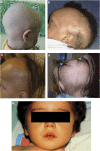Mutations in the vitamin D receptor and hereditary vitamin D-resistant rickets
- PMID: 24818002
- PMCID: PMC4015455
- DOI: 10.1038/bonekey.2014.5
Mutations in the vitamin D receptor and hereditary vitamin D-resistant rickets
Abstract
Heterogeneous loss of function mutations in the vitamin D receptor (VDR) interfere with vitamin D signaling and cause hereditary vitamin D-resistant rickets (HVDRR). HVDRR is characterized by hypocalcemia, secondary hyperparathyroidism and severe early-onset rickets in infancy and is often associated with consanguinity. Affected children may also exhibit alopecia of the scalp and total body. The children usually fail to respond to treatment with calcitriol; in fact, their endogenous levels are often very elevated. Successful treatment requires reversal of hypocalcemia and secondary hyperparathyroidism and is usually accomplished by administration of high doses of calcium given either intravenously or sometimes orally to bypass the intestinal defect in VDR signaling.
Conflict of interest statement
The authors declare no conflict of interest.
Figures


Similar articles
-
Hereditary 1,25-dihydroxyvitamin D-resistant rickets (HVDRR): clinical heterogeneity and long-term efficacious management of eight patients from four unrelated Arab families with a loss of function VDR mutation.J Pediatr Endocrinol Metab. 2018 Aug 28;31(8):861-868. doi: 10.1515/jpem-2017-0312. J Pediatr Endocrinol Metab. 2018. PMID: 29949513
-
Hereditary 1,25-dihydroxyvitamin D-resistant rickets due to an opal mutation causing premature termination of the vitamin D receptor.J Bone Miner Res. 1998 Feb;13(2):259-64. doi: 10.1359/jbmr.1998.13.2.259. J Bone Miner Res. 1998. PMID: 9495519
-
Tooth Development Associated with Mutations in Hereditary Vitamin D-Resistant Rickets.JDR Clin Trans Res. 2018 Jan;3(1):28-34. doi: 10.1177/2380084417732510. Epub 2017 Sep 20. JDR Clin Trans Res. 2018. PMID: 30938651
-
Lessons Learned from Hereditary 1,25-Dihydroxyvitamin D-Resistant Rickets Patients on Vitamin D Functions.J Nutr. 2021 Mar 11;151(3):473-481. doi: 10.1093/jn/nxaa380. J Nutr. 2021. PMID: 33438017 Review.
-
Vitamin D receptor defects: the story of hereditary resistance to vitamin D.Pediatr Endocrinol Rev. 2006 Aug;3 Suppl 3:470-5. Pediatr Endocrinol Rev. 2006. PMID: 17551468 Review.
Cited by
-
Vitamin D-Resistant Rickets Diagnostics and Treatment Challenges at Muhimbili National Hospital, Tanzania.Case Rep Endocrinol. 2020 Jan 28;2020:1547170. doi: 10.1155/2020/1547170. eCollection 2020. Case Rep Endocrinol. 2020. PMID: 32082647 Free PMC article.
-
Novel Vitamin D Receptor Mutations in Hereditary Vitamin D Resistant Rickets in Chinese.PLoS One. 2015 Sep 30;10(9):e0138152. doi: 10.1371/journal.pone.0138152. eCollection 2015. PLoS One. 2015. PMID: 26422470 Free PMC article.
-
Vitamin D: Metabolism, Molecular Mechanism of Action, and Pleiotropic Effects.Physiol Rev. 2016 Jan;96(1):365-408. doi: 10.1152/physrev.00014.2015. Physiol Rev. 2016. PMID: 26681795 Free PMC article. Review.
-
Dysregulation and gene polymorphisms of Vitamin D receptor: its implications in lipid metabolic disorders.Mol Biol Rep. 2025 Jun 23;52(1):630. doi: 10.1007/s11033-025-10725-7. Mol Biol Rep. 2025. PMID: 40549261 Review.
-
Vitamin D and Its Receptor from a Structural Perspective.Nutrients. 2022 Jul 12;14(14):2847. doi: 10.3390/nu14142847. Nutrients. 2022. PMID: 35889804 Free PMC article. Review.
References
-
- Feldman D, Pike JW, Adams JS (eds). Vitamin D. Third Edn Elsiever: San Diego, CA, USA, 2011.
Publication types
LinkOut - more resources
Full Text Sources
Other Literature Sources
Medical
